Comprehensive Report: Breastfeeding Class for Antenatal Women
VerifiedAdded on 2023/01/18
|9
|2469
|84
Report
AI Summary
This report details a health education program focused on breastfeeding for antenatal women, covering various essential aspects. The report outlines the aims of the lesson, which include educating women about breast milk production, its importance for both mother and child, and addressing the demands of breast milk. It emphasizes the benefits of breastfeeding, such as the ideal nutrition for babies, the presence of antibodies, and reduced risks of infections and allergies. The report also discusses the foods to be avoided during breastfeeding, like caffeine and certain dairy products, and provides guidance on preventing and managing nipple soreness. The content section elaborates on the importance of breastfeeding, the mother's nutritional needs, and the impact of proper food intake on milk production. The report also suggests teaching aids like handouts with breastfeeding techniques and positions. The teaching strategies involve group work to cover different outcomes and ensure understanding, and the importance of evaluating the lesson through feedback forms to assess the program's effectiveness and identify areas for improvement. The report is enriched with references to support the information provided.
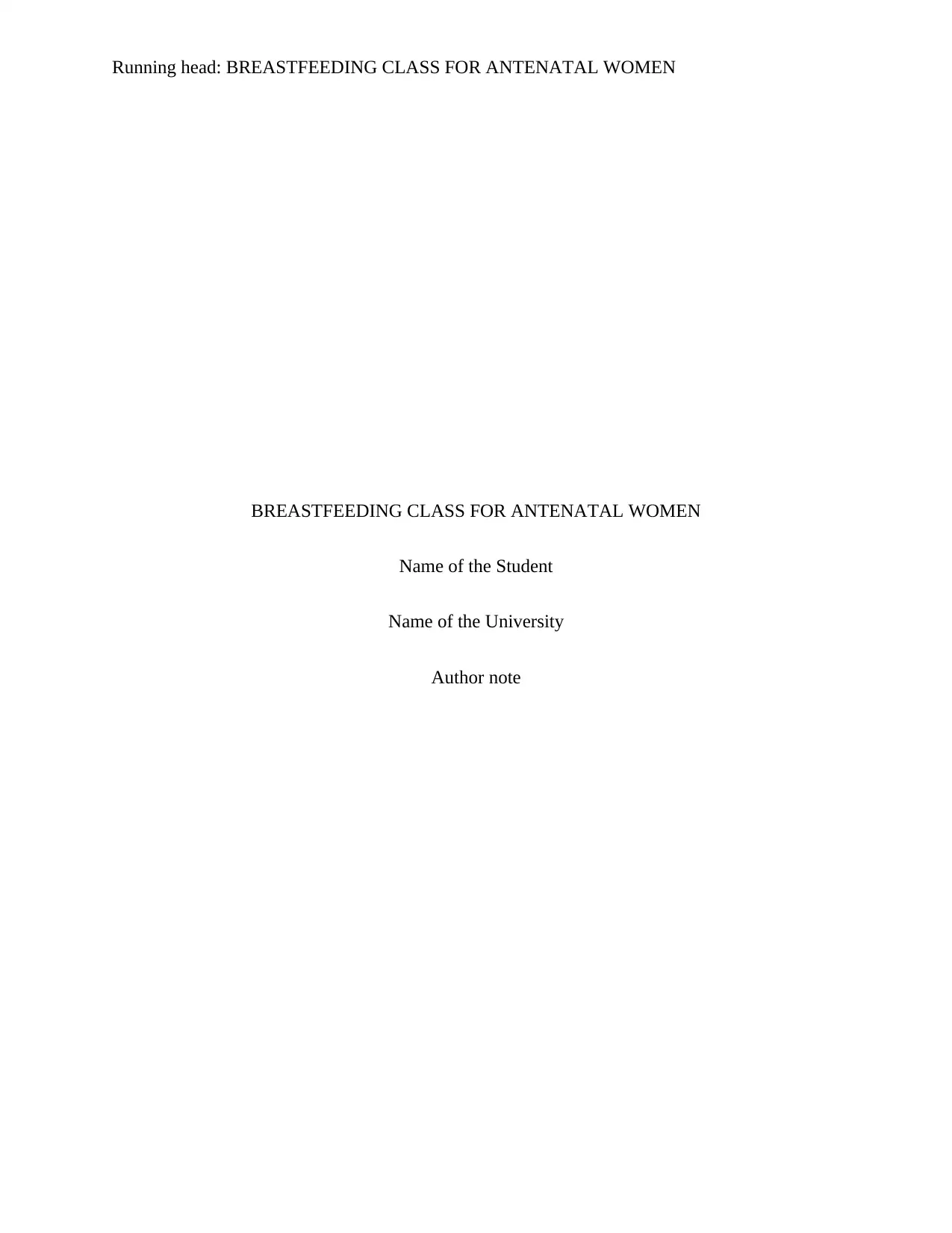
Running head: BREASTFEEDING CLASS FOR ANTENATAL WOMEN
BREASTFEEDING CLASS FOR ANTENATAL WOMEN
Name of the Student
Name of the University
Author note
BREASTFEEDING CLASS FOR ANTENATAL WOMEN
Name of the Student
Name of the University
Author note
Paraphrase This Document
Need a fresh take? Get an instant paraphrase of this document with our AI Paraphraser
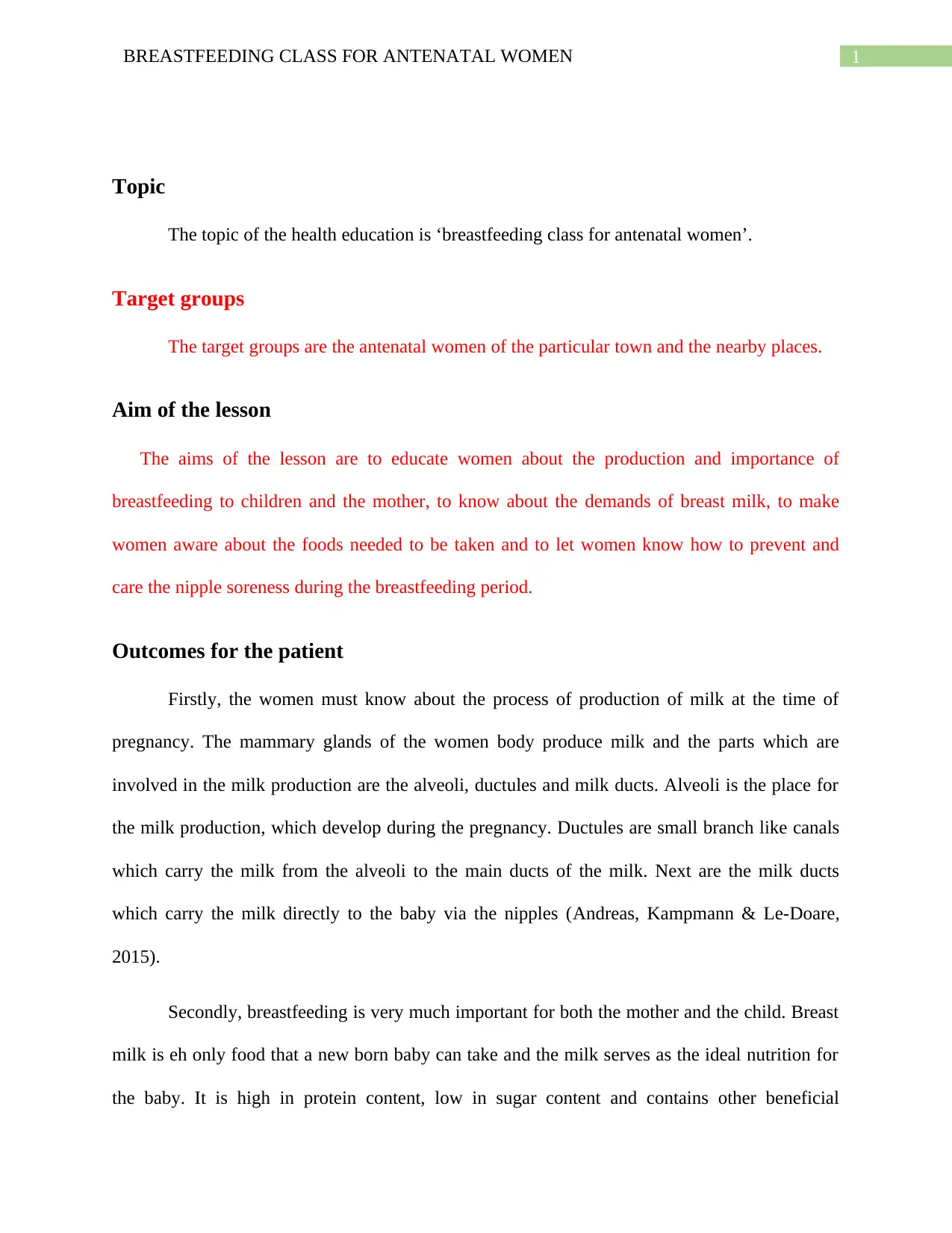
1BREASTFEEDING CLASS FOR ANTENATAL WOMEN
Topic
The topic of the health education is ‘breastfeeding class for antenatal women’.
Target groups
The target groups are the antenatal women of the particular town and the nearby places.
Aim of the lesson
The aims of the lesson are to educate women about the production and importance of
breastfeeding to children and the mother, to know about the demands of breast milk, to make
women aware about the foods needed to be taken and to let women know how to prevent and
care the nipple soreness during the breastfeeding period.
Outcomes for the patient
Firstly, the women must know about the process of production of milk at the time of
pregnancy. The mammary glands of the women body produce milk and the parts which are
involved in the milk production are the alveoli, ductules and milk ducts. Alveoli is the place for
the milk production, which develop during the pregnancy. Ductules are small branch like canals
which carry the milk from the alveoli to the main ducts of the milk. Next are the milk ducts
which carry the milk directly to the baby via the nipples (Andreas, Kampmann & Le-Doare,
2015).
Secondly, breastfeeding is very much important for both the mother and the child. Breast
milk is eh only food that a new born baby can take and the milk serves as the ideal nutrition for
the baby. It is high in protein content, low in sugar content and contains other beneficial
Topic
The topic of the health education is ‘breastfeeding class for antenatal women’.
Target groups
The target groups are the antenatal women of the particular town and the nearby places.
Aim of the lesson
The aims of the lesson are to educate women about the production and importance of
breastfeeding to children and the mother, to know about the demands of breast milk, to make
women aware about the foods needed to be taken and to let women know how to prevent and
care the nipple soreness during the breastfeeding period.
Outcomes for the patient
Firstly, the women must know about the process of production of milk at the time of
pregnancy. The mammary glands of the women body produce milk and the parts which are
involved in the milk production are the alveoli, ductules and milk ducts. Alveoli is the place for
the milk production, which develop during the pregnancy. Ductules are small branch like canals
which carry the milk from the alveoli to the main ducts of the milk. Next are the milk ducts
which carry the milk directly to the baby via the nipples (Andreas, Kampmann & Le-Doare,
2015).
Secondly, breastfeeding is very much important for both the mother and the child. Breast
milk is eh only food that a new born baby can take and the milk serves as the ideal nutrition for
the baby. It is high in protein content, low in sugar content and contains other beneficial
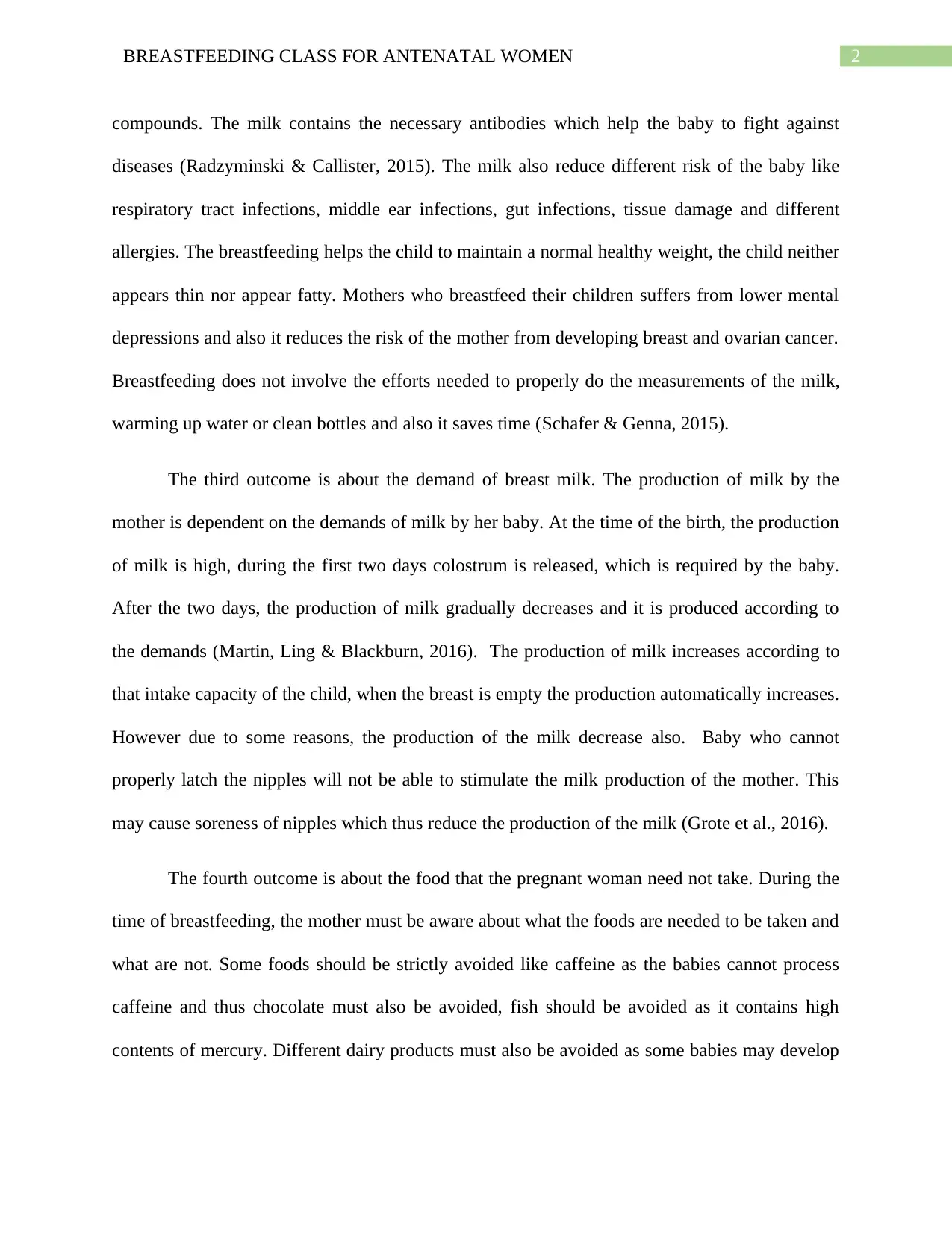
2BREASTFEEDING CLASS FOR ANTENATAL WOMEN
compounds. The milk contains the necessary antibodies which help the baby to fight against
diseases (Radzyminski & Callister, 2015). The milk also reduce different risk of the baby like
respiratory tract infections, middle ear infections, gut infections, tissue damage and different
allergies. The breastfeeding helps the child to maintain a normal healthy weight, the child neither
appears thin nor appear fatty. Mothers who breastfeed their children suffers from lower mental
depressions and also it reduces the risk of the mother from developing breast and ovarian cancer.
Breastfeeding does not involve the efforts needed to properly do the measurements of the milk,
warming up water or clean bottles and also it saves time (Schafer & Genna, 2015).
The third outcome is about the demand of breast milk. The production of milk by the
mother is dependent on the demands of milk by her baby. At the time of the birth, the production
of milk is high, during the first two days colostrum is released, which is required by the baby.
After the two days, the production of milk gradually decreases and it is produced according to
the demands (Martin, Ling & Blackburn, 2016). The production of milk increases according to
that intake capacity of the child, when the breast is empty the production automatically increases.
However due to some reasons, the production of the milk decrease also. Baby who cannot
properly latch the nipples will not be able to stimulate the milk production of the mother. This
may cause soreness of nipples which thus reduce the production of the milk (Grote et al., 2016).
The fourth outcome is about the food that the pregnant woman need not take. During the
time of breastfeeding, the mother must be aware about what the foods are needed to be taken and
what are not. Some foods should be strictly avoided like caffeine as the babies cannot process
caffeine and thus chocolate must also be avoided, fish should be avoided as it contains high
contents of mercury. Different dairy products must also be avoided as some babies may develop
compounds. The milk contains the necessary antibodies which help the baby to fight against
diseases (Radzyminski & Callister, 2015). The milk also reduce different risk of the baby like
respiratory tract infections, middle ear infections, gut infections, tissue damage and different
allergies. The breastfeeding helps the child to maintain a normal healthy weight, the child neither
appears thin nor appear fatty. Mothers who breastfeed their children suffers from lower mental
depressions and also it reduces the risk of the mother from developing breast and ovarian cancer.
Breastfeeding does not involve the efforts needed to properly do the measurements of the milk,
warming up water or clean bottles and also it saves time (Schafer & Genna, 2015).
The third outcome is about the demand of breast milk. The production of milk by the
mother is dependent on the demands of milk by her baby. At the time of the birth, the production
of milk is high, during the first two days colostrum is released, which is required by the baby.
After the two days, the production of milk gradually decreases and it is produced according to
the demands (Martin, Ling & Blackburn, 2016). The production of milk increases according to
that intake capacity of the child, when the breast is empty the production automatically increases.
However due to some reasons, the production of the milk decrease also. Baby who cannot
properly latch the nipples will not be able to stimulate the milk production of the mother. This
may cause soreness of nipples which thus reduce the production of the milk (Grote et al., 2016).
The fourth outcome is about the food that the pregnant woman need not take. During the
time of breastfeeding, the mother must be aware about what the foods are needed to be taken and
what are not. Some foods should be strictly avoided like caffeine as the babies cannot process
caffeine and thus chocolate must also be avoided, fish should be avoided as it contains high
contents of mercury. Different dairy products must also be avoided as some babies may develop
⊘ This is a preview!⊘
Do you want full access?
Subscribe today to unlock all pages.

Trusted by 1+ million students worldwide
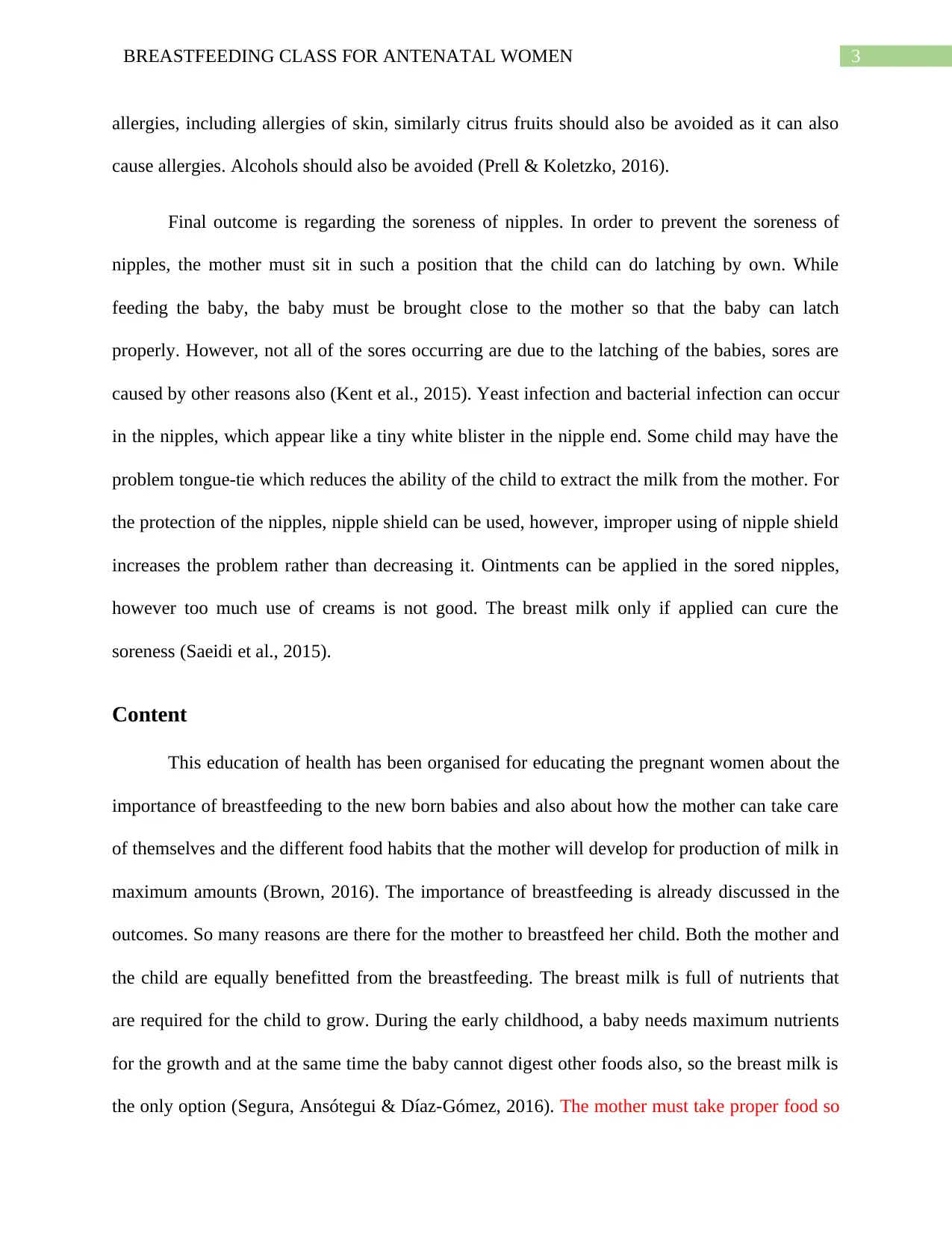
3BREASTFEEDING CLASS FOR ANTENATAL WOMEN
allergies, including allergies of skin, similarly citrus fruits should also be avoided as it can also
cause allergies. Alcohols should also be avoided (Prell & Koletzko, 2016).
Final outcome is regarding the soreness of nipples. In order to prevent the soreness of
nipples, the mother must sit in such a position that the child can do latching by own. While
feeding the baby, the baby must be brought close to the mother so that the baby can latch
properly. However, not all of the sores occurring are due to the latching of the babies, sores are
caused by other reasons also (Kent et al., 2015). Yeast infection and bacterial infection can occur
in the nipples, which appear like a tiny white blister in the nipple end. Some child may have the
problem tongue-tie which reduces the ability of the child to extract the milk from the mother. For
the protection of the nipples, nipple shield can be used, however, improper using of nipple shield
increases the problem rather than decreasing it. Ointments can be applied in the sored nipples,
however too much use of creams is not good. The breast milk only if applied can cure the
soreness (Saeidi et al., 2015).
Content
This education of health has been organised for educating the pregnant women about the
importance of breastfeeding to the new born babies and also about how the mother can take care
of themselves and the different food habits that the mother will develop for production of milk in
maximum amounts (Brown, 2016). The importance of breastfeeding is already discussed in the
outcomes. So many reasons are there for the mother to breastfeed her child. Both the mother and
the child are equally benefitted from the breastfeeding. The breast milk is full of nutrients that
are required for the child to grow. During the early childhood, a baby needs maximum nutrients
for the growth and at the same time the baby cannot digest other foods also, so the breast milk is
the only option (Segura, Ansótegui & Díaz-Gómez, 2016). The mother must take proper food so
allergies, including allergies of skin, similarly citrus fruits should also be avoided as it can also
cause allergies. Alcohols should also be avoided (Prell & Koletzko, 2016).
Final outcome is regarding the soreness of nipples. In order to prevent the soreness of
nipples, the mother must sit in such a position that the child can do latching by own. While
feeding the baby, the baby must be brought close to the mother so that the baby can latch
properly. However, not all of the sores occurring are due to the latching of the babies, sores are
caused by other reasons also (Kent et al., 2015). Yeast infection and bacterial infection can occur
in the nipples, which appear like a tiny white blister in the nipple end. Some child may have the
problem tongue-tie which reduces the ability of the child to extract the milk from the mother. For
the protection of the nipples, nipple shield can be used, however, improper using of nipple shield
increases the problem rather than decreasing it. Ointments can be applied in the sored nipples,
however too much use of creams is not good. The breast milk only if applied can cure the
soreness (Saeidi et al., 2015).
Content
This education of health has been organised for educating the pregnant women about the
importance of breastfeeding to the new born babies and also about how the mother can take care
of themselves and the different food habits that the mother will develop for production of milk in
maximum amounts (Brown, 2016). The importance of breastfeeding is already discussed in the
outcomes. So many reasons are there for the mother to breastfeed her child. Both the mother and
the child are equally benefitted from the breastfeeding. The breast milk is full of nutrients that
are required for the child to grow. During the early childhood, a baby needs maximum nutrients
for the growth and at the same time the baby cannot digest other foods also, so the breast milk is
the only option (Segura, Ansótegui & Díaz-Gómez, 2016). The mother must take proper food so
Paraphrase This Document
Need a fresh take? Get an instant paraphrase of this document with our AI Paraphraser
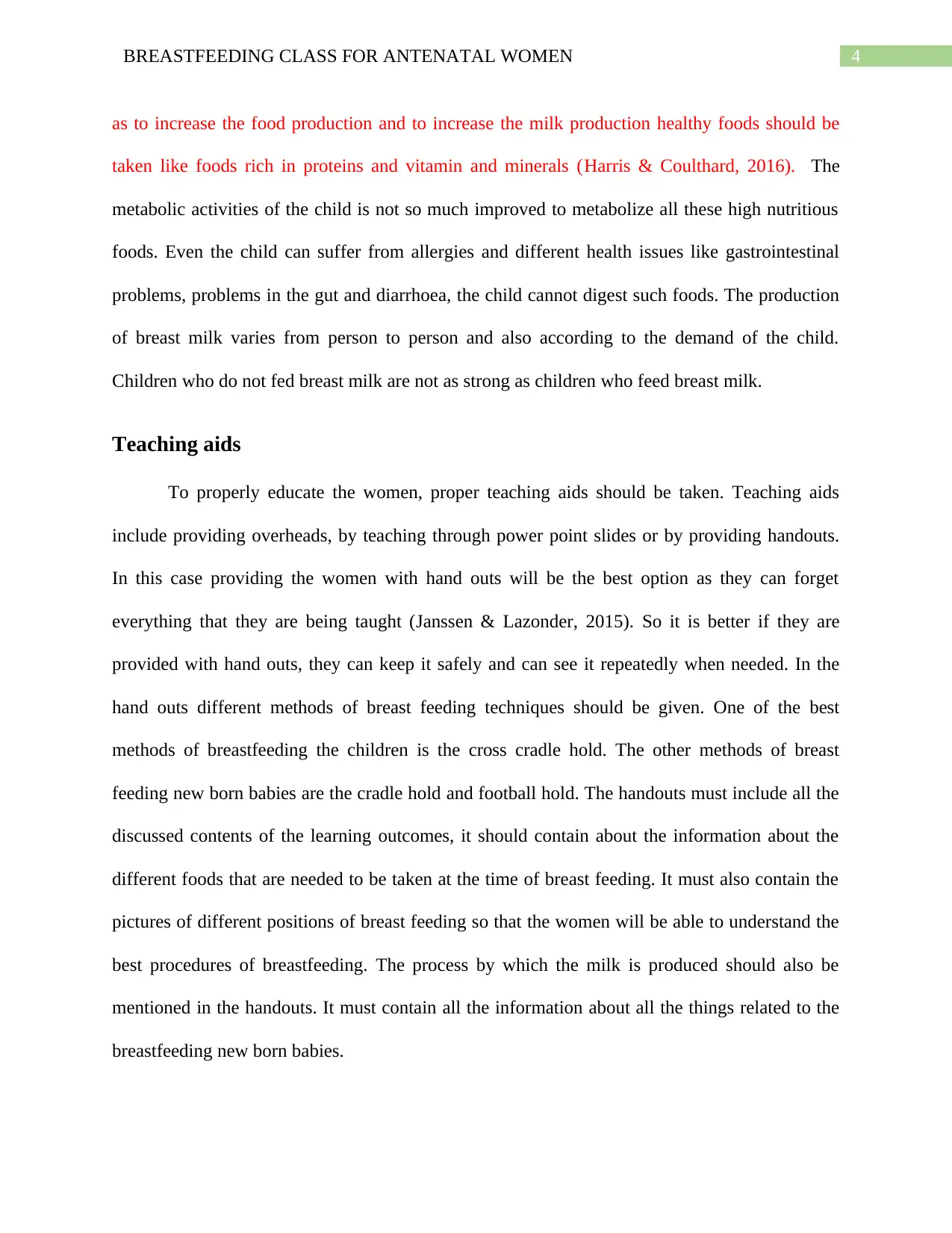
4BREASTFEEDING CLASS FOR ANTENATAL WOMEN
as to increase the food production and to increase the milk production healthy foods should be
taken like foods rich in proteins and vitamin and minerals (Harris & Coulthard, 2016). The
metabolic activities of the child is not so much improved to metabolize all these high nutritious
foods. Even the child can suffer from allergies and different health issues like gastrointestinal
problems, problems in the gut and diarrhoea, the child cannot digest such foods. The production
of breast milk varies from person to person and also according to the demand of the child.
Children who do not fed breast milk are not as strong as children who feed breast milk.
Teaching aids
To properly educate the women, proper teaching aids should be taken. Teaching aids
include providing overheads, by teaching through power point slides or by providing handouts.
In this case providing the women with hand outs will be the best option as they can forget
everything that they are being taught (Janssen & Lazonder, 2015). So it is better if they are
provided with hand outs, they can keep it safely and can see it repeatedly when needed. In the
hand outs different methods of breast feeding techniques should be given. One of the best
methods of breastfeeding the children is the cross cradle hold. The other methods of breast
feeding new born babies are the cradle hold and football hold. The handouts must include all the
discussed contents of the learning outcomes, it should contain about the information about the
different foods that are needed to be taken at the time of breast feeding. It must also contain the
pictures of different positions of breast feeding so that the women will be able to understand the
best procedures of breastfeeding. The process by which the milk is produced should also be
mentioned in the handouts. It must contain all the information about all the things related to the
breastfeeding new born babies.
as to increase the food production and to increase the milk production healthy foods should be
taken like foods rich in proteins and vitamin and minerals (Harris & Coulthard, 2016). The
metabolic activities of the child is not so much improved to metabolize all these high nutritious
foods. Even the child can suffer from allergies and different health issues like gastrointestinal
problems, problems in the gut and diarrhoea, the child cannot digest such foods. The production
of breast milk varies from person to person and also according to the demand of the child.
Children who do not fed breast milk are not as strong as children who feed breast milk.
Teaching aids
To properly educate the women, proper teaching aids should be taken. Teaching aids
include providing overheads, by teaching through power point slides or by providing handouts.
In this case providing the women with hand outs will be the best option as they can forget
everything that they are being taught (Janssen & Lazonder, 2015). So it is better if they are
provided with hand outs, they can keep it safely and can see it repeatedly when needed. In the
hand outs different methods of breast feeding techniques should be given. One of the best
methods of breastfeeding the children is the cross cradle hold. The other methods of breast
feeding new born babies are the cradle hold and football hold. The handouts must include all the
discussed contents of the learning outcomes, it should contain about the information about the
different foods that are needed to be taken at the time of breast feeding. It must also contain the
pictures of different positions of breast feeding so that the women will be able to understand the
best procedures of breastfeeding. The process by which the milk is produced should also be
mentioned in the handouts. It must contain all the information about all the things related to the
breastfeeding new born babies.
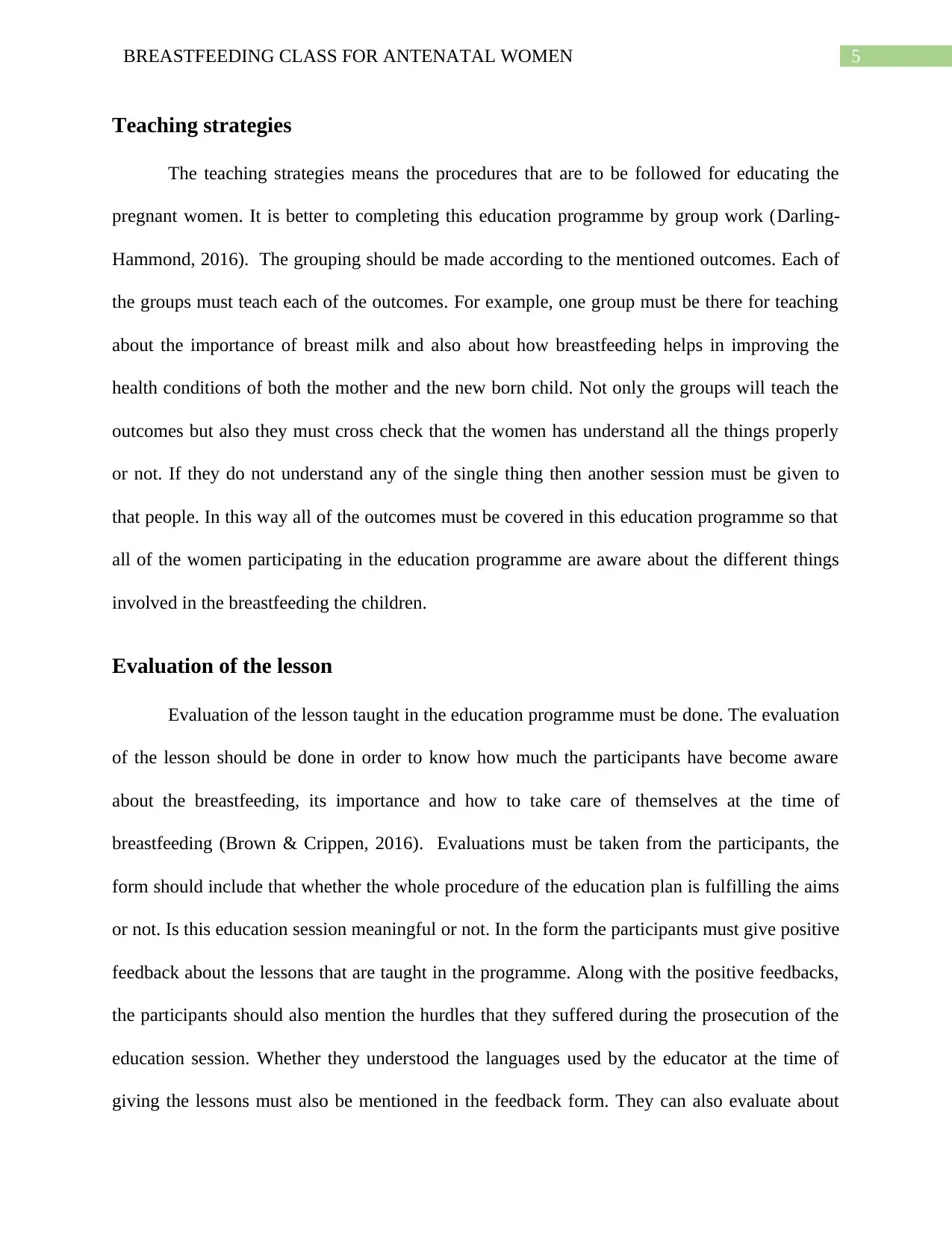
5BREASTFEEDING CLASS FOR ANTENATAL WOMEN
Teaching strategies
The teaching strategies means the procedures that are to be followed for educating the
pregnant women. It is better to completing this education programme by group work (Darling-
Hammond, 2016). The grouping should be made according to the mentioned outcomes. Each of
the groups must teach each of the outcomes. For example, one group must be there for teaching
about the importance of breast milk and also about how breastfeeding helps in improving the
health conditions of both the mother and the new born child. Not only the groups will teach the
outcomes but also they must cross check that the women has understand all the things properly
or not. If they do not understand any of the single thing then another session must be given to
that people. In this way all of the outcomes must be covered in this education programme so that
all of the women participating in the education programme are aware about the different things
involved in the breastfeeding the children.
Evaluation of the lesson
Evaluation of the lesson taught in the education programme must be done. The evaluation
of the lesson should be done in order to know how much the participants have become aware
about the breastfeeding, its importance and how to take care of themselves at the time of
breastfeeding (Brown & Crippen, 2016). Evaluations must be taken from the participants, the
form should include that whether the whole procedure of the education plan is fulfilling the aims
or not. Is this education session meaningful or not. In the form the participants must give positive
feedback about the lessons that are taught in the programme. Along with the positive feedbacks,
the participants should also mention the hurdles that they suffered during the prosecution of the
education session. Whether they understood the languages used by the educator at the time of
giving the lessons must also be mentioned in the feedback form. They can also evaluate about
Teaching strategies
The teaching strategies means the procedures that are to be followed for educating the
pregnant women. It is better to completing this education programme by group work (Darling-
Hammond, 2016). The grouping should be made according to the mentioned outcomes. Each of
the groups must teach each of the outcomes. For example, one group must be there for teaching
about the importance of breast milk and also about how breastfeeding helps in improving the
health conditions of both the mother and the new born child. Not only the groups will teach the
outcomes but also they must cross check that the women has understand all the things properly
or not. If they do not understand any of the single thing then another session must be given to
that people. In this way all of the outcomes must be covered in this education programme so that
all of the women participating in the education programme are aware about the different things
involved in the breastfeeding the children.
Evaluation of the lesson
Evaluation of the lesson taught in the education programme must be done. The evaluation
of the lesson should be done in order to know how much the participants have become aware
about the breastfeeding, its importance and how to take care of themselves at the time of
breastfeeding (Brown & Crippen, 2016). Evaluations must be taken from the participants, the
form should include that whether the whole procedure of the education plan is fulfilling the aims
or not. Is this education session meaningful or not. In the form the participants must give positive
feedback about the lessons that are taught in the programme. Along with the positive feedbacks,
the participants should also mention the hurdles that they suffered during the prosecution of the
education session. Whether they understood the languages used by the educator at the time of
giving the lessons must also be mentioned in the feedback form. They can also evaluate about
⊘ This is a preview!⊘
Do you want full access?
Subscribe today to unlock all pages.

Trusted by 1+ million students worldwide

6BREASTFEEDING CLASS FOR ANTENATAL WOMEN
the ways that can be followed by the committee so that the negatives could be covered. If the
participants want, they can also suggest the committee to follow some other methods or policies
so that this type of education programme can be done in a better way.
the ways that can be followed by the committee so that the negatives could be covered. If the
participants want, they can also suggest the committee to follow some other methods or policies
so that this type of education programme can be done in a better way.
Paraphrase This Document
Need a fresh take? Get an instant paraphrase of this document with our AI Paraphraser
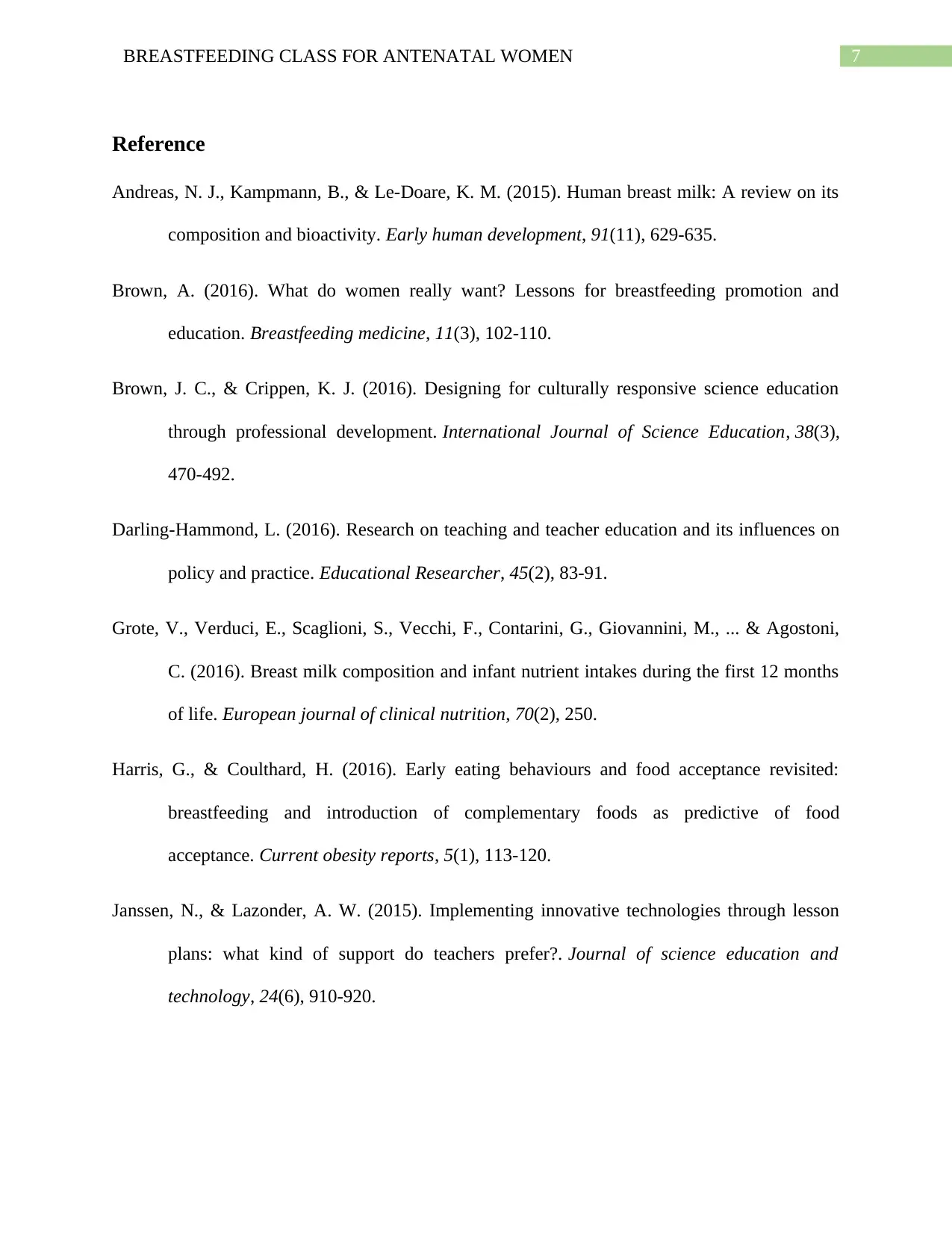
7BREASTFEEDING CLASS FOR ANTENATAL WOMEN
Reference
Andreas, N. J., Kampmann, B., & Le-Doare, K. M. (2015). Human breast milk: A review on its
composition and bioactivity. Early human development, 91(11), 629-635.
Brown, A. (2016). What do women really want? Lessons for breastfeeding promotion and
education. Breastfeeding medicine, 11(3), 102-110.
Brown, J. C., & Crippen, K. J. (2016). Designing for culturally responsive science education
through professional development. International Journal of Science Education, 38(3),
470-492.
Darling-Hammond, L. (2016). Research on teaching and teacher education and its influences on
policy and practice. Educational Researcher, 45(2), 83-91.
Grote, V., Verduci, E., Scaglioni, S., Vecchi, F., Contarini, G., Giovannini, M., ... & Agostoni,
C. (2016). Breast milk composition and infant nutrient intakes during the first 12 months
of life. European journal of clinical nutrition, 70(2), 250.
Harris, G., & Coulthard, H. (2016). Early eating behaviours and food acceptance revisited:
breastfeeding and introduction of complementary foods as predictive of food
acceptance. Current obesity reports, 5(1), 113-120.
Janssen, N., & Lazonder, A. W. (2015). Implementing innovative technologies through lesson
plans: what kind of support do teachers prefer?. Journal of science education and
technology, 24(6), 910-920.
Reference
Andreas, N. J., Kampmann, B., & Le-Doare, K. M. (2015). Human breast milk: A review on its
composition and bioactivity. Early human development, 91(11), 629-635.
Brown, A. (2016). What do women really want? Lessons for breastfeeding promotion and
education. Breastfeeding medicine, 11(3), 102-110.
Brown, J. C., & Crippen, K. J. (2016). Designing for culturally responsive science education
through professional development. International Journal of Science Education, 38(3),
470-492.
Darling-Hammond, L. (2016). Research on teaching and teacher education and its influences on
policy and practice. Educational Researcher, 45(2), 83-91.
Grote, V., Verduci, E., Scaglioni, S., Vecchi, F., Contarini, G., Giovannini, M., ... & Agostoni,
C. (2016). Breast milk composition and infant nutrient intakes during the first 12 months
of life. European journal of clinical nutrition, 70(2), 250.
Harris, G., & Coulthard, H. (2016). Early eating behaviours and food acceptance revisited:
breastfeeding and introduction of complementary foods as predictive of food
acceptance. Current obesity reports, 5(1), 113-120.
Janssen, N., & Lazonder, A. W. (2015). Implementing innovative technologies through lesson
plans: what kind of support do teachers prefer?. Journal of science education and
technology, 24(6), 910-920.

8BREASTFEEDING CLASS FOR ANTENATAL WOMEN
Kent, J., Ashton, E., Hardwick, C., Rowan, M., Chia, E., Fairclough, K., ... & Geddes, D. (2015).
Nipple pain in breastfeeding mothers: incidence, causes and treatments. International
journal of environmental research and public health, 12(10), 12247-12263.
Martin, C., Ling, P. R., & Blackburn, G. (2016). Review of infant feeding: key features of breast
milk and infant formula. Nutrients, 8(5), 279.
Prell, C., & Koletzko, B. (2016). Breastfeeding and complementary feeding: recommendations
on infant nutrition. Deutsches Ärzteblatt International, 113(25), 435.
Radzyminski, S., & Callister, L. C. (2015). Health professionals’ attitudes and beliefs about
breastfeeding. The journal of perinatal education, 24(2), 102.
Saeidi, R., Tafazoli, M., Gholami, M., & Mazloom, R. (2015). New treatment for nipple soreness
in breastfeeding mothers: A clinical trial study. Iranian Journal of Neonatology IJN, 6(2),
48-51.
Schafer, R., & Genna, C. W. (2015). Physiologic breastfeeding: a contemporary approach to
breastfeeding initiation. Journal of midwifery & Women's health, 60(5), 546-553.
Segura, S. A., Ansótegui, J. A., & Díaz-Gómez, N. M. (2016). The importance of maternal
nutrition during breastfeeding: Do breastfeeding mothers need nutritional
supplements?. Anales de Pediatría (English Edition), 84(6), 347-e1.
Kent, J., Ashton, E., Hardwick, C., Rowan, M., Chia, E., Fairclough, K., ... & Geddes, D. (2015).
Nipple pain in breastfeeding mothers: incidence, causes and treatments. International
journal of environmental research and public health, 12(10), 12247-12263.
Martin, C., Ling, P. R., & Blackburn, G. (2016). Review of infant feeding: key features of breast
milk and infant formula. Nutrients, 8(5), 279.
Prell, C., & Koletzko, B. (2016). Breastfeeding and complementary feeding: recommendations
on infant nutrition. Deutsches Ärzteblatt International, 113(25), 435.
Radzyminski, S., & Callister, L. C. (2015). Health professionals’ attitudes and beliefs about
breastfeeding. The journal of perinatal education, 24(2), 102.
Saeidi, R., Tafazoli, M., Gholami, M., & Mazloom, R. (2015). New treatment for nipple soreness
in breastfeeding mothers: A clinical trial study. Iranian Journal of Neonatology IJN, 6(2),
48-51.
Schafer, R., & Genna, C. W. (2015). Physiologic breastfeeding: a contemporary approach to
breastfeeding initiation. Journal of midwifery & Women's health, 60(5), 546-553.
Segura, S. A., Ansótegui, J. A., & Díaz-Gómez, N. M. (2016). The importance of maternal
nutrition during breastfeeding: Do breastfeeding mothers need nutritional
supplements?. Anales de Pediatría (English Edition), 84(6), 347-e1.
⊘ This is a preview!⊘
Do you want full access?
Subscribe today to unlock all pages.

Trusted by 1+ million students worldwide
1 out of 9
Related Documents
Your All-in-One AI-Powered Toolkit for Academic Success.
+13062052269
info@desklib.com
Available 24*7 on WhatsApp / Email
![[object Object]](/_next/static/media/star-bottom.7253800d.svg)
Unlock your academic potential
Copyright © 2020–2025 A2Z Services. All Rights Reserved. Developed and managed by ZUCOL.



